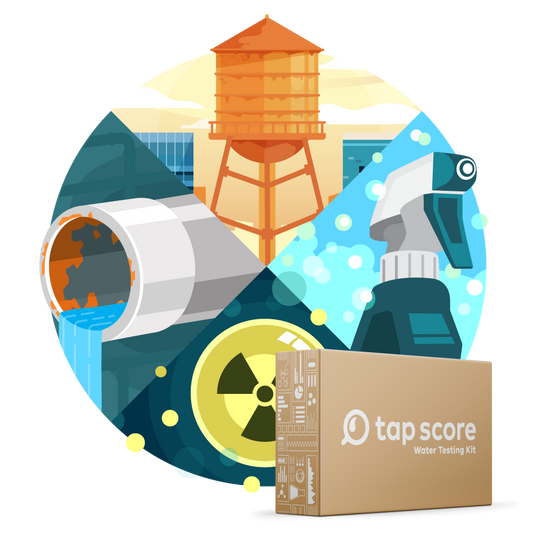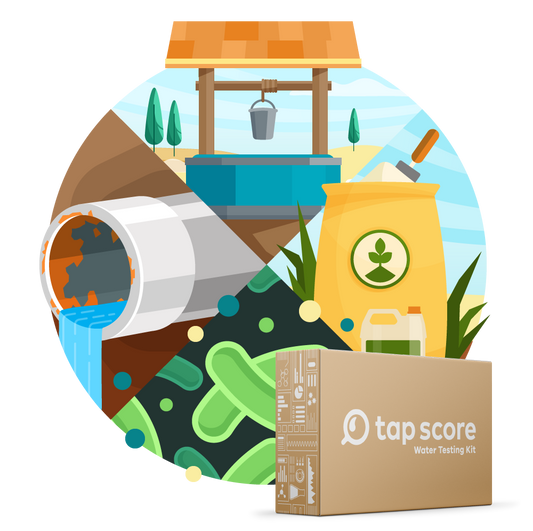
Ohio Train Derailment: Water Quality FAQ
Our blog is written by real experts— not AI. Each guide is carefully reviewed and updated based on the latest research. Plus, with no affiliate links, you can count on unbiased insights you can trust.
Last updated: March 9, 2023 at 2:40 PM PST.
Following the East Palestine, Ohio train derailment that occurred on February 3, 2023 we've received an overwhelming amount of questions. The SimpleLab team initially created an internal document for our customer support team, but we've decided to make it public to better help people reaching out to us.
It covers some of the contaminants that may be threatening local drinking water, like vinyl chloride, and how to test for it.
This is an ongoing story and will be updated as we learn more. For the most up to date version of what we know, click here.
Here is what we know about the East Palestine, OH train derailment so far...
Tap Score by SimpleLab specializes in testing drinking water. We advise on treatment but do not sell water treatment products, nor do we work as affiliates for treatment brands.
There is ongoing uncertainty around the incident. This document will be updated as we learn more.
Questions: Ask us on live chat or email at support@mytapscore.com
What was spilled?
EPA has said that the following chemicals were known to have been released into the air, ground and water:
-
Vinyl chloride
-
Butyl acrylate
-
Ethylhexyl acrylate
-
Ethylene glycol monobutyl ether
-
Isobutylene
These are industrial chemicals used to make products like PVC, rubber, paint, and other chemicals. They are all volatile, meaning they readily partition into the air, and are known as volatile organic compounds or VOCs. You can be exposed to these chemicals via ingestion, dermal contact or inhalation. Exposure to high concentrations of any of these chemicals can cause adverse reactions including respiratory irritation, nausea, headache, etc., but these concentrations aren’t likely in drinking water.
There were likely many more chemicals involved in the original spill that are not on this list. We are tracking sampling results and adding any additional chemicals of concern below.
Should I be concerned about any other chemicals?
-
DIOXINS: Both US Senators from Ohio, J. D. Vance and Sherrod Brown, have called for the EPA to monitor dioxins in relation to the fire at the derailment site.
Dioxins can be formed during combustion of waste and, specifically, from the combustion of vinyl chloride. It is unclear if the fires produced significant levels of these compounds and there is not currently any monitoring data on them that has been released. Dioxins are highly toxic chemicals that can cause cancer, reproductive and developmental impacts, harm to the immune systems, and impact hormones. They are very persistent and do not break down quickly in the environment, but they are NOT the same chemicals as PFAS (often referred to as “forever chemicals”). Read more on PFAS below.When released to the environment, dioxins tend to bind to soil and sediment rather than remain dissolved in water. If dioxins are found in water, activated carbon treatment is recommended for their removal. Based on their properties, dioxins should also be effectively removed from water by reverse osmosis.
-
PFAS: We have recently heard concerns about PFAS, or per- and polyfluoroalkyl substances, contamination in reference to the derailment. PFAS have been confused with dioxins because both of these classes of compounds are persistent in the environment, earning them nicknames like “forever chemicals”. PFAS and dioxins are NOT the same.
PFAS are used in various consumer products, including non-stick pans, food wrappers, paper, waterproof fabrics, cleaning products, carpeting, and electronics. They build up not only in the environment, but also in the human body, and have been found to cause a variety of adverse health impacts. PFAS can impact the liver and cause cholesterol changes, impair the immune system, cause developmental effects and cause cancer, among other impacts.PFAS are also used in some Class B firefighting foams, which are used to put out fires that involve gasoline, oil, solvents and other flammable liquids. Right now, we don’t know if PFAS were in the firefighting foams used to put out the fire at the derailment site.
If PFAS are found in water, activated carbon, ion exchange, reverse osmosis and nanofiltration are recommended for their removal.
-
ETHYLENE GLYCOL MONOBUTYL ETHER: We have seen questions about ethylene glycol in reference to the derailment as well. We believe this is likely a misunderstanding regarding one of the chemicals involved in the spill, ethylene glycol monobutyl ether. These are different compounds and ethylene glycol monobutyl ether does not typically break down into ethylene glycol in the environment.However, ethylene glycol can be used in the production of ethylene glycol monobutyl ether. We believe ethylene glycol is not relevant at this point.
-
2-ETHYLHEXANOL: We have also seen various entities begin to monitor for 2-ethylhexanol. It was detected once at the intake of Cincinnati’s water utility (while the intake was closed), but has not been detected since and was not detected at other sites along the Ohio River. 2-Ethylhexanol is a precursor to ethylhexyl acrylate, one of the chemicals involved in the spill, and is used in the manufacture of plasticizers for PVC. According to guidelines established by EPA, there is “suggestive evidence of carcinogenic potential” for 2-ethylhexanol but the data is not sufficient to definitively conclude that it is a human carcinogen.
2-Ethylhexanol has been detected in creeks that feed the Ohio River. It was also detected once at the intake of Cincinnati’s water utility (while the intake was closed), but has not been detected since and was not detected at other sites along the Ohio River.
Will this spill affect my drinking water?
It is possible for these chemicals to get into the drinking water supply, either public utility water drawn from the Ohio River or wells in the area, but it is not a guarantee that drinking water will be impacted.
The federal and state branches of the EPA are monitoring surface and groundwater in the area of the spill and along the Ohio River, and public drinking water in the area. The Ohio River Valley Water Sanitation Commission, or ORSANCO, is conducting monitoring at various points along the Ohio River, and many drinking water utilities along the Ohio River are monitoring their intake water for contamination as well.
Butyl acrylate, ethylhexyl acrylate, vinyl chloride, ethylene glycol monobutyl ether and 2-ethylhexanol have been detected in creeks that feed the Ohio River, some as recently as 02/25. Butyl acrylate was also detected at very low concentrations at various points along the Ohio River as recently at 02/17.
Out of an abundance of caution, the drinking water utility for Cincinnati closed its intake on the Ohio River from very early Sunday morning (02/19) until midday Tuesday (02/21) in order to avoid any potential contamination from the plume–they have not detected any of the chemicals from the spill in their daily monitoring that began on the day of the spill and is ongoing. While the intake was closed, they detected very low concentrations of 2-ethyl-1-hexanol in the river. It has not been detected since and it did not impact drinking water because the intake was closed.
Results of Ohio EPA’s monitoring of surface water in East Palestine.
Results of monitoring of the Ohio River by ORSANCO.
We have compiled a list of utilities with intakes on the Ohio River that may be affected by the plume.
East Palestine’s municipal drinking water is drawn from five wells, all of which are at least 1.4 miles away from the derailment site towards the west/northwest. The groundwater that supplies the wells flows in from the northwest, which means that any groundwater in the area of the derailment won’t reach the wells because it’s in the opposite direction of the groundwater flow.
However, the creek Sulphur Run, which was heavily impacted by the spill, comes very close to the eastern edge of the groundwater source zone based on modeling done by the Ohio EPA (diagram below). For extra safety, four monitoring wells were installed between the drinking water wells and the impacted streams (Sulphur Run and Leslie Run downstream of Sulphur Run). Any contamination from the impacted streams would reach the monitoring wells before it reached the municipal wells so the monitoring wells would serve as an early warning system if that were to happen.

Source: https://epa.ohio.gov/monitor-pollution/pollution-issues/east-palestine
Results of sampling of East Palestine’s drinking water on 02/10, 02/12 and 02/21 have been released and there were no detections of the chemicals originally implicated in the spill (ethylene glycol monobutyl ether and isobutylene were not measured). There were some issues with some of the samples that could impact results, and there were detections of other compounds (besides those originally involved in the spill) in some samples. However, without more information about the sample locations and the baseline water quality, it is hard to further interpret these results.
Results of Ohio EPA’s monitoring of East Palestine’s public drinking water are here.
As of 02/26, 121 private wells had been sampled in Ohio and Pennsylvania by the Columbiana County Health District. Results of sampling done between 02/10 and 02/22 have been released and there were no detections of the chemicals originally implicated in the spill. There were detections of other compounds in some samples but without more information, we cannot further interpret these results.
Results of sampling of private wells in the East Palestine area are posted here.
The Ohio Department of Health recommends that residents with private wells use bottled water until their well testing results come back.
Keep in mind that these chemicals are volatile so if they are present in your drinking water, you may be exposed to them not just by ingesting the contaminated water, but also by inhaling the vapors when cooking, doing dishes, bathing, etc.
How concerned should I be about my health?
These chemicals are hazardous to human health in both air and water, but the extent of the potential risk depends on the concentrations of the contaminants and the duration of the exposure.
One of these chemicals–vinyl chloride–is regularly monitored in drinking water. Vinyl chloride is carcinogenic and the EPA has set its maximum contaminant level goal (MCLG) in drinking water at 0. This means there is no known safe concentration of vinyl chloride in drinking water assuming a lifetime of exposure.
You can test for vinyl chloride in water with a lab testing kit for VOCs.
Volatile Organic Compounds (VOCs) Water Test Kit
Tests for 60 different VOCs, including vinyl chloride.
If you get tap water from a public water system or utility then you're probably OK. Utilities in the area are monitoring their source water and prepared to deal with the situation if contamination is detected.
If you get your drinking water from a private well, you are responsible for your own water quality. Pay attention to the news and any reports of contamination reaching groundwater nearby. We don’t know right now if these chemicals will make it into groundwater and, if they do, if they will reach water that supplies private wells.
Are public utilities doing anything about this contamination?
Yes. Various utilities in the immediate area of the derailment and others that source water from the Ohio River have announced that they are carefully monitoring their intake water for contamination and have alternative sources on standby in case contamination is detected.
In addition, they have announced that they have either enhanced their treatment processes or have additional treatment ready in case it’s needed.
I’m on public utility water, should I test my water? What should I test for?
If you’re on public utility water you are not at high risk of health impacts because there are professional engineers who oversee your drinking water quality and treatment plant operations.
These personnel have already been alerted to the spill and its potential risks. They are monitoring the raw water supply for indicators of dangerous concentrations of any of the contaminants.
If you want to test your water for peace of mind, we’d suggest the following:
Volatile Organic Compounds (VOCs) Water Test Kit
Tests for 60 different VOCs, including vinyl chloride.
Ethylene Glycol Monobutyl Ether Water Test Kit
Tests specifically for ethylene glycol monobutyl ether.
I’m on spring/well water, should I test my water? What should I test for?
You’re more likely to be at risk if you’re on private well water or spring water than if you’re on public tap water because there is no professional oversight of the water quality in your well. However, it is currently unclear whether the spill will impact nearby wells.
Residents of areas immediately surrounding the spill site are eligible for free well testing. Refer to this website for phone numbers to call to request free testing and speak with toxicologists.
If you have a private or shared well or spring water supply and you want to test your water for contamination related to this spill, we suggest the following:
Volatile Organic Compounds (VOCs) Water Test Kit
Tests for 60 different VOCs, including vinyl chloride.(Recommended.)
Ethylene Glycol Monobutyl Ether Water Test Kit
Tests specifically for ethylene glycol monobutyl ether.
Advanced Well Water Test Kit
Tests for 60 different VOCs (including vinyl chloride) plus 52 additional parameters, like heavy metals.
We are not sure if these compounds are currently relevant but you can test for them:
Dioxins and Furans Water Test Kit
Tests for 17 different dioxins and furans
PFAS Water Test Kit
Tests for 14 different PFAS (aka “forever chemicals”)
How often should I test?
The truth is that we currently do not know.
If you’re on well water it’s important to test once or twice a year, regardless of nearby conditions. However, in a situation like this one there are too many variables to give a strong recommendation for testing frequency. Make sure to pay attention to the news and, specifically, to reports about the results of local groundwater sampling campaigns so you know if contamination is detected in groundwater near you. If so, it is advisable to test your water right away.
Referring to the originally spilled chemicals (VOCs):
What can I do to remove these chemicals from my water?
Because these compounds are volatile, it is best to remove them from all of the water entering your house. This means treatment at the wellhead or point-of-entry is best. Aeration and activated carbon treatment systems are recommended for reduction of volatile organic compounds, like those involved in the spill.
Multi-stage treatment systems may also include an activated carbon step—this is often the case for reverse osmosis systems, for example.
Will boiling my water help?
Boiling your water is not advised—volatile chemicals like those released in this spill are released into the air when water is boiled and become inhalation hazards.
Will distillation help?
Distillation is not recommended—in general, distillation is not recommended for the removal of volatile organic compounds. If the target compounds have boiling points near that of water, distillation will not adequately remove them.
Will my water softener help?
A water softener will not remove these compounds from your drinking water.
The ion exchange technology used in water softeners is not effective for the removal of volatile organic compounds like those released in this spill.
Will reverse osmosis help?
It depends—small molecules with no charge, like those released in this spill, are not always removed well by reverse osmosis. Specifically, we know that vinyl chloride often makes it through reverse osmosis membranes. However, RO may reduce some of the chemicals, it just depends on which ones end up in your water.
Many RO systems come with an activated carbon filtration stage. This stage should take care of the VOCs.
About Tap Score and SimpleLab:
Tap Score by SimpleLab specializes in testing drinking water. We advise on treatment but do not sell water treatment products, nor do we work as affiliates for treatment brands.
Single water samples are for informational purposes only and not admissible in court. Typically for a sample to have any legal standing, courts will define the specifications/certifications required, and arrange a certified sampler to collect and transport the samples to the lab. It usually requires MANY samples (not just one).
There is ongoing uncertainty around the incident. This document will be updated as we learn more.
Questions: Ask us via live chat or email at support@mytapscore.com





